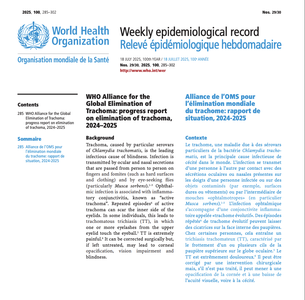Key statistics

WHO Alliance for the Global Elimination of Trachoma: progress report on elimination of trachoma, 2024
Data to inform these messages are derived from the GET2020 database and the WHO Weekly Epidemiological Review annual updates on trachoma. ICTC strongly encourages its membership and all trachoma stakeholders to utilize these figures for consistency of messaging.
Trachoma is the world’s leading infectious cause of blindness and one of 21 neglected tropical diseases (NTDs) that affect over one billion of the world’s poorest people - Source: WHO
102.6 million people live in trachoma endemic areas - Source: WHO Weekly Epidemiological Record
Trachoma is responsible for the visual impairment or blindness of about 1.9 million people - Source: World Report on Vision, 2019
27 countries have been validated by WHO as having eliminated trachoma as a public health problem (Benin, Burundi, Cambodia, China, Egypt, Fiji, The Gambia, Ghana, India, the Islamic Republic of Iran, Iraq, the Kingdom of Saudi Arabia, Lao People’s Democratic Republic, Malawi, Mali, Mauritania, Mexico, Morocco, Myanmar, Nepal, Oman, Pakistan, Papua New Guinea, Saudi Arabia, Senegal, Togo, Vanuatu, Viet Nam) - Source: GET2020 database October 2025
5 countries have reported achieving the prevalence targets for trachoma elimination (Botswana, Guinea-Bissau, Libya, Namibia, Tunisia) - Source: GET2020 database October 2025
The estimated number of individuals with trachomatous trichiasis, the stage of trachoma that can cause blindness, reduced by 84% from 7.6 million in 2002 to 1.2 million in 2025 - Source: WHO Weekly Epidemiological Record
In 2024, 44.4 million people received antibiotics for trachoma - Source: WHO Weekly Epidemiological Record
As of April 2025, Ethiopia, accounted for 64% of the global burden of trachoma, with 66 million people at risk - Source: WHO Weekly Epidemiological Record
Women are 1.8 times more likely to require surgery than men to treat trachomatous trichiasis, the stage of trachoma that can cause blindnessSource: WHO Weekly Epidemiological Record